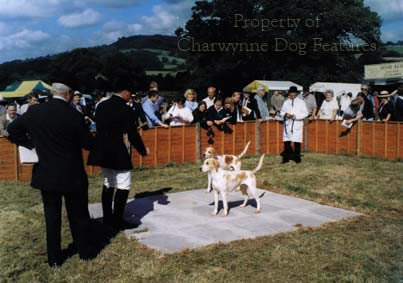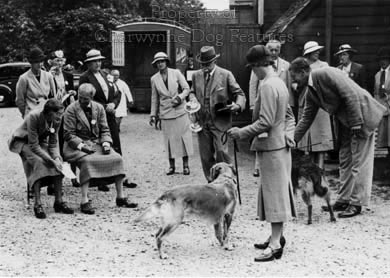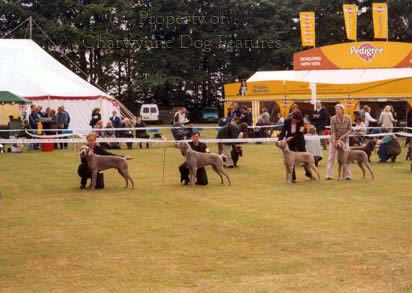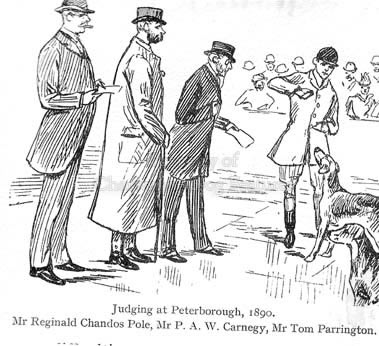145 THE PERILS OF EXPOSING FAULTS
THE PERILS OF EXPOSING FAULTS
by David Hancock
 I was recently taken to task by a former Master of Foxhounds for criticising the technique of judges at the Honiton Hound Show. He took issue with my dislike of the (to me) demeaning practice of showering the ring with hound-meal to animate the hounds. In reply to my concern that the judges didn't examine mouths or place hands on the exhibits, he stated that all hounds had good mouths so an examination wasn't necessary and that 'judges can clearly see the hounds are in good shape.' This line of reasoning doesn't seem to embrace KC-licensed conformation shows or lurcher and terrier shows, where function dictates form.
I was recently taken to task by a former Master of Foxhounds for criticising the technique of judges at the Honiton Hound Show. He took issue with my dislike of the (to me) demeaning practice of showering the ring with hound-meal to animate the hounds. In reply to my concern that the judges didn't examine mouths or place hands on the exhibits, he stated that all hounds had good mouths so an examination wasn't necessary and that 'judges can clearly see the hounds are in good shape.' This line of reasoning doesn't seem to embrace KC-licensed conformation shows or lurcher and terrier shows, where function dictates form.
A few years ago, in comparable vein, I was criticised by a Fox Terrier breeder for stating that the exhibits I saw at a particular show all suffered from upright shoulders. With delightful naivety this breeder pointed out that their breed standard demanded shoulders that were 'long and sloping, well laid back', implying that this alone should prevent any occurrence of such a fault. There was a hint too in both these correspondents that no 'outsider' should intrude in such matters. This 'hands off our breed' attitude came through strongly, when I expressed concern over the modern Bull Terrier's rugger-ball head twenty years ago. The dominant breeder of that time said very dogmatically in reply: Mind your own business!
Against that background, it is very easy to understand how faults and uncharacteristic features develop in breeds, almost unseen. At the end of the 19th century and on into Edwardian times, the Foxhound went through what has been termed its 'shorthorn era'. Experienced Foxhound breeders became convinced that the only good Foxhound was one with a massive forehand, heavy round bone in the forelimbs, knuckled-over knees and toeing-in on the forefeet. For men from that background to subscribe to such transparent idiocy shows how even in a wholly functional breed, breed fanciers can become hopelessly lost.
In his 'Hold Hard! Hounds, Please!' of 1924, the author, using the pseudonym 'Yoi-Over', himself a huntsman and whipper-in to many well-known packs, tried to justify this 'carthorse' philosophy. He wrote: "Some will say, why have a hound so massive to hunt an animal the size of a fox...the reason is this...the same fox is rarely hunted twice in the one day...a hound may be called upon to hunt several foxes in one day." He seemed to be arguing that bulk is the basis of stamina, yet rode a hunter to accompany the hounds, not a carthorse. 
This author went on to write: "It has been the aim of the hound-breeder during the last forty or fifty years to get as much bone into the wrist, and as short, as possible..." He was misusing the expression 'hound-breeder', for no French pack of scenthounds, no German hound breed and no American Foxhound was bred to this flawed design. It took the stature and reputation of the great Foxhound breeder 'Ikey' Bell to restore sanity to the Foxhound fraternity on this subject. But if men using their dogs functionally can get so lost, it is less surprising when breeders of companion or ornamental dogs do too.
There will be howls of protest when I write this, but just about every breed of sporting terrier in the show ring has upright shoulders and short upper arms. This is indicated in their lack of forward extension, abbreviated front stride and chopping front action. The TV commentators, in their fawning enthusiasm at Crufts, see this as 'the dog simply flowing over the ground' but it is a bad fault in a sporting breed. The pursuit of the upstanding docked tail in most of these breeds has also led to a shortened back, a lack of angle in the pelvis and therefore a shortened rear stride. None of these features is desirable in an earth-dog.
Am I right about terriers in the show ring? What are the judges saying? Here are some of their comments. Cairn Terriers (1999): "I found some awful movement, both front and rear. Front movement with stilted action and no forward reach, as well as pinning in, elbows out was not uncommon." Miniature Bull Terriers (1998): "Upright shoulders, lack of bone and substance and bad movement seem to be the norm..." The Airedale Terrier judge at Crufts in 1998 noted "...the absence of really well laid back shoulders..." The West Highland White Terrier judge at the same show observed that "...Upper-arms were short and pelvises upright..." At the South Wales Kennel Association show in 1997, the Airedale judge gave this view: "Movement in Airedales had deteriorated to the extent that I cannot honestly say that any one of the ones I judged could be classed as having excellent movement. The best I would rate as passable and the worst as appalling."
Are we losing the ability to breed sporting terriers with the correct construction and sound movement? The Cairn Terrier judge at Crufts in 1995 wrote that: "Having seen the very good movement of the Cairns in Denmark and the States last year, I was very disappointed with the movement of our own dogs..." The West Highland Terrier judge at Crufts in 1996 wrote: "The other faults I found appalling were the number of very dodgy mouths, along with very poor construction. To think these dogs had to qualify in order to enter Crufts leaves me speechless." If I were the chairman of the breed council in these breeds, I would be alarmed enough to convene a seminar to discuss such damning critiques. But I have yet to hear of such a measure being taken. 
The 1994 Airedale Crufts judge made some points for me in the show critique: "I am sorry to say that the anatomic structure of most of the Airedales shown in the ring, even if they were champions, was more or less incorrect...It is only possible to produce a well laid back shoulder...if upper arm and shoulder blade are the same length." Sadly five years later the Airedale Crufts judge was to report that "Movement, as always, is not as it should be." Ten years ago, in my book 'The Heritage of the Dog', I wrote of my concern over the front action and incorrectly placed shoulders in this breed. My publisher sent on to me an irate letter from an Airedale breeder to the effect that the breed was fine and didn't need my interference. Who was right?
If we carry on as we are, in so many breeds of sporting terrier, the placement of shoulders, the length of upper arm in particular, will be beyond repair from our gene pool. What a comment on British breeders! I accept that many Toy breeds have just about no extension fore and aft when moving, a fault concealed by the heavy coat displayed by some of these breeds. But, for me, sound movement based on correct construction is an over-riding requirement in a sporting breed. Clearly, from my quotes, there are plenty of judges expressing concern about this, but is it having any effect? Perhaps the irrational jealousy and rivalry found within many breed clubs prevents their listening to their own breed specialist judges. This is where knowledgeable all-rounders and even outsiders can surely help.
In my experience, the greatest danger in far too many breeds comes, not from the newcomers bursting to learn and discuss their recently-acquired knowledge, but from the 'thirty years in the breed' brigade. So often the latter have not thirty years experience but one year's experience repeated thirty times. They have fixed views, quite often outdated views but even worse than that, closed minds. When I speak at breed seminars, I am invariably disappointed by the older breeders in the room and greatly encouraged by the younger ones. When I attend breed seminars, I can sometimes hardly believe what I am hearing - and these are the training grounds for future judges.
At a Bullmastiff breed seminar a couple of years ago, a breed elder gave the view that the only effective night-dog could be one well over 100lbs, stating that a lighter dog could never knock and then hold a man down. The most effective night-dogs were however Thorneywood Terror, Osmaston Grip and Osmaston Daisy, each weighing around 90lbs. A later speaker and well-known judge stated that she didn't believe in withholding prizes, this despite the Kennel Club's rules on this subject. At a previous Bullmastiff breed seminar, where I was a speaker, an older breeder told the gathering that he didn't agree with anything I had said (which is fine by me) but when challenged to say why, could only mutter about having been thirty years in the breed, as if that by itself could present some cogent reason to disagree.
A couple of years ago I had the privilege of interviewing the late Gwen Broadley when making a commercial video on the Labrador. She was then in her 90s but so very alert and lively. Her experience was extensive, her knowledge considerable, her opinions well-formed. But what was so striking was her open mind, her willingness to discuss her breed and her obvious enjoyment of the views of an 'outsider'. I was immensely impressed; her humility was quite remarkable in one who had done so much, seen so much, yet never stopped learning. For me, it is a treasured experience. This distinguished lady didn't hide behind her experience, she built on it.
I wonder if today's Foxhound breeders have learned the lesson of their 'shorthorn' period. If Hound Show judges are never going to examine mouths 'because they just know they are all good', standby for inbred jaw construction problems in these hounds. If no Hound Show judge is going to inspect the feet of hounds, standby for inbred foot and pastern problems. How on earth can any breeder improve his line if judges decline to conduct a thorough physical examination and merely assume that faults don't exist. Objective judgements can contribute a great deal to breeder awareness.
If all-rounder judges are devalued by breed fanciers, then a valuable 'outsider' view is not being capitalised upon. If breed specialist judges and all-rounders provide important comments for breeders which is then ignored, then a breed is in peril. I have mentioned my concern about an epidemic of upright shoulders and short upper arms in breeds of sporting terriers. Show critiques have also highlighted the prevalence of upright shoulders in 11 other breeds and short upper arms in 10 breeds. Judges have also lamented the 'choppy' action in Alaskan Malamutes and 'terrier movement' in Beagles. The latter comment by a judge is in itself worrying; is it becoming the expectation to see a marked lack of extension in terrier breeds? Is an abbreviated front action becoming a terrier characteristic?
The Lancashire Heeler judge at Crufts in 1999 noted that "Shoulders varied considerably with quite a large number having very short and upright upper arms." This judge was awarding the breed's first challenge certificates. But how did heelers with such basic faults ever qualify for Crufts? The Kennel Club is striving to improve the standard of judging but any judge who cannot judge shoulders should not be appointed. We want our dogs, for all the importance of breed points, to be able to walk with freedom and purpose. In some breeds, (I have given the example of Airedales), basic faults are reported time and time again by judges in their critiques. Who is safeguarding the future of these breeds?
No doubt I will be told to mind my own business because I am not 'in' the breeds I refer to. But perhaps a more valuable comment than 'What's he know?' is the more intelligent one of 'Is he right?' 'Mind your own business' is negative and often the sign of an insecure closed mind. 'Hands off our breed' is defensive and does nothing to open up a breed to informed constructive comment. Neither presents a healthy option for a breed whose fanciers wish to enter a new millennium with ambition for their breed. Unless we are very careful harmful faults are going to become accepted as breed characteristics. There should be no such thing as 'terrier movement' only sound movement, however short the dog's legs are. No dog should be forced to take three strides when one will do.
The late Tom Horner, a distinguished terrier judge, wrote in his 'All About the Bull Terrier': "Dogs with really good shoulders and good length of upper arm hardly ever go wrong in front, whereas dogs with short upper arms and short steep shoulder blades with a wide angle between the two bones frequently do..." The Staffordshire Bull Terrier expert, HN Beilby, wrote in his book on the breed: "Front legs may be well boned and muscled, but if they are coupled with badly placed shoulders they lose a considerable proportion of their usefulness and efficiency." This of course applies to all breeds; I do hope that whether the advice comes from within breeds or without, we can get back to breeding dogs with 'useful, efficient' front legs, just as Beilby recommends. Assuming or pretending that all is hunky-dorey in the pedigree dog world is a recipe for disaster; living with inbred faults or knowingly overlooking flaws does nothing for our servant the dog. Dogs need us to protect them - sadly quite often from their own breeders!